

In 1947 a new set of uniform regulations was issued, in large part a consolidation the numerous changes that had been made since 1941. 1 Khaki had been reestablished as the standard for working uniforms in 1946, 2 and the gold shoulder marks and gold buttons had been re-authorized for the gray working uniform. 3 Working gray could not be worn after October 1949.
Also in 1947, legislation dealing with the armed forces' medical services changed the title of pharmacists to "warrant officer, hospital corps." 4

cap badge
| collar devices |  |  |  |  |  |  |
| shoulder marks |   |   |   |   |   |   |
| collar devices |  |  |  |  |  |  |  |
| shoulder marks |   |   |   |   |   |   |   |

cap badge
| collar devices |  |  |  |  |  |  |
| shoulder marks |   |   |   |   |   |   |
| collar devices |  |  |  |  |  |  |  |
| shoulder marks |   |   |   |   |   |   |   |
In 1949, the Career Compensation Act replaced officers' former pay "periods" with pay grades. For warrant officers, four grades were authorized, numbered W-1 through W-4. 5 The actual ranks were unchanged, however: Warrant officers were grade W-1, and commissioned warrant officers started at W-2 and could advance to W-3 and W-4 pay as their career progressed.
The initial distribution of existing WO's and CWO's into the new grades was as follows:
| rank | seniority | new pay grade |
|---|---|---|
| Warrant officer | (any) | W-1 |
| Commissioned warrant officer | under 6 years as CWO | W-2 |
| over 6 but under 12 years as CWO | W-3 | |
| over 12 years as CWO | W-4 |
A new edition of uniform regulations was issued in 1951. 6 The biggest change for warrant officers in the 1951 regulations was authorization of a metal pin rank device for the first time. Similar to an ensign's gold bar but with blue breaks, the new bars were based on those worn by Marine Corps CWOs and WOs since 1943. The new bars would be worn on the right side of the shirt collar and the corps devices on the left, in the same manner as commissioned officers. The metal pin corps devices were standardized as gold for CWOs as well as WOs. The bars were also worn on the right side of the garrison cap, and a new crossed foul anchor miniature cap device was authorized for warrant officers for the left side of the garrison cap. Since the 1951 regulations also authorized larger metal insignia for the shoulders of raincoats, the new bars came in two sizes. The old insignia were permitted until July 1, 1952.
The insignia for carpenter, Civil Engineer Corps was deleted from teh regulations, and the photographer device was changed to show a front view of a camera instead of the back.
 | 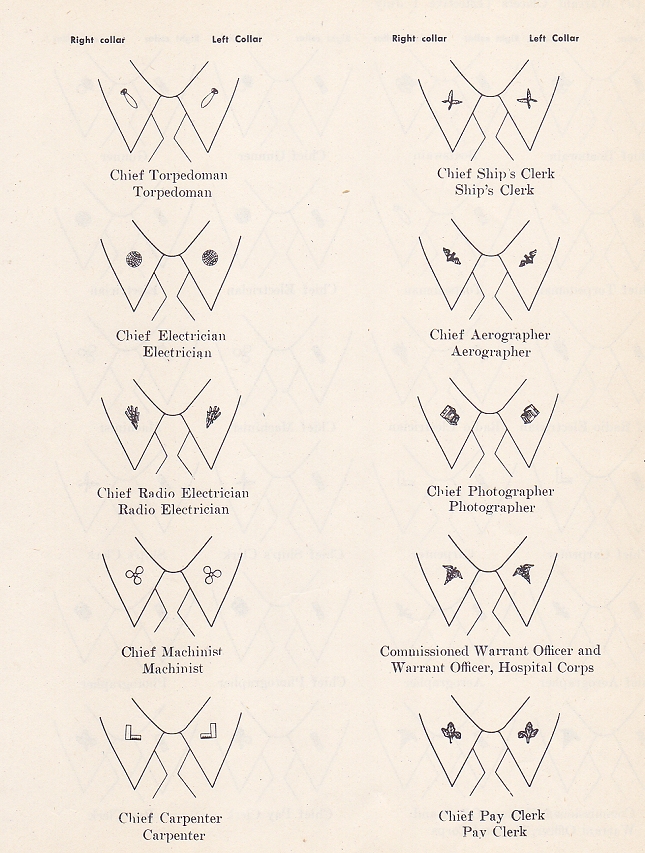 | 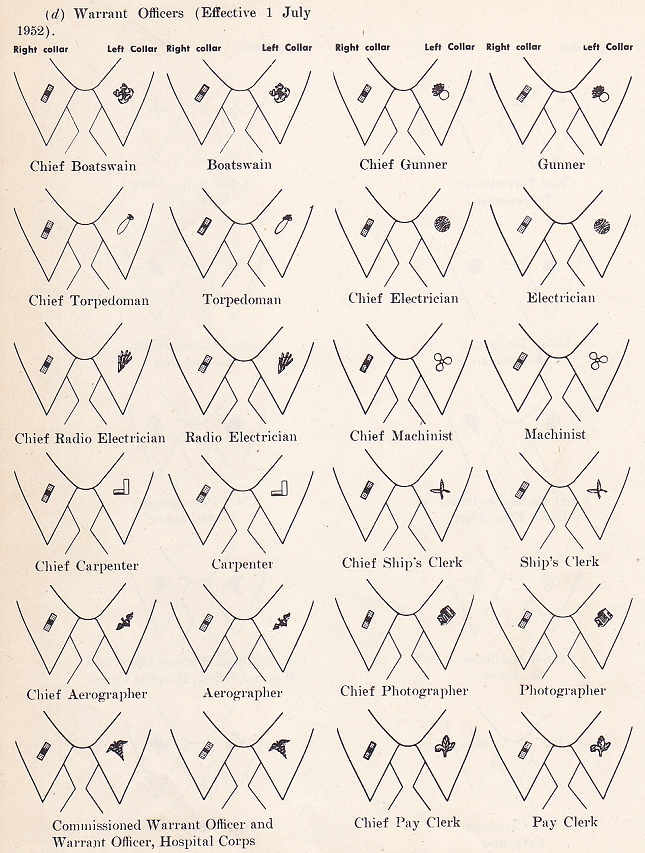 |
| The changes in warrant collar devices as illustrated in the 1951 U.S. Navy Uniform Regulations (click for larger images). Author's collection. | ||
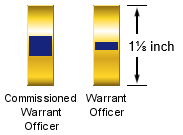 | 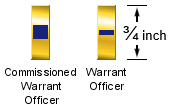 | shoulder size | collar and garrison cap size |

cap badge
| collar devices |   |   |   |   |   |   |
| shoulder marks |  |  |  |  |  |  |
| collar devices |   |   |   |   |   |   |
| shoulder marks |  |  |  |  |  |  |

cap badge
| collar devices |   |   |   |   |   |   |
| shoulder marks |  |  |  |  |  |  |
| collar devices |   |   |   |   |   |   |
| shoulder marks |  |  |  |  |  |  |
The 1951 regulations also specified that insignia for female officers be the same as for males with one exception: On service dress white rank was to be indicated by sleeve stripes of white braid, and the corps device in yellow embroidery. For warrant officers, the breaks in the stripes were yellow.
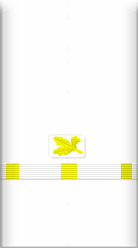 |
| Chief Pay Clerk, Women's Service Dress White |
In 1954, the Warrant Officer Act created four separate ranks for the W-1 through W-4 pay grades. 7 The rank titles authorized were:
As a result of this legislation, the Defense Department established a committee of officers representing the four armed services to deliberate on insignia for the new ranks. In August 1954 the Assistant Secretary of Defense (Manpower and Personnel) approved the committee's recommendations for new metal and enamel rank bars, 8 with a different color of enamel for each service:
| Army | Navy, Coast Guard | Air Force | Marine Corps | |
| CW-4 |  |  |  |  |
| CW-3 |  |  |  |  |
| CW-2 |  |  |  |  |
| W-1 |  |  |  |  |
The Navy adopted the new bars in place of the short-lived gold and blue metal warrant rank insignia of 1952. The uniform regulations described the new bars this way :
Warrant Officers – A bar 1 ⅛" in length, ⅜" in width; to have blue enamel background with silver or gold marking as follows:
Chief Warrant Officer W-4 – Blue background with two 1 /4" silver breaks across, separated by 1 /4" of blue background in the center.
Chief Warrant Officer W-3 – Blue background broken across the center by a silver stripe 1 /4" wide.
Chief Warrant Officer W-2 – Same as for Chief Warrant Officer W-4 except that gold metal shall be substituted for silver where appearing.
Warrant Officer W-1 – Same as for Chief Warrant Officer W-3 except that gold metal shall be substituted for silver where appearing. 9
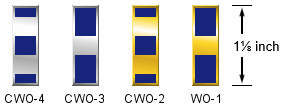 |  | shoulder size | collar and garrison cap size |
The Navy had the additional task of expanding its sleeve and shoulder mark insignia. Instead of augmenting existing insignia, a different approach was used, similar to the heraldic principle of "differencing," wherein the basic design is "senior," and the more differences added the more "junior" the design becomes. Chief warrant officer W-4 would have one break in its rank stripe, W-3 two, and W-2, three. W-1 would also have three breaks, but on the narrower quarter-inch stripe as before. This allowed existing W-1 and W-2 sleeve insignia to go unchanged. The breaks and spacing were narrowed for use on the shoulder marks. The Navy announced the new insignia in October 1954, 10 and incorporated them into the uniform regulations in March 1955. 9 Personnel had until November 1, 1955 to change over to the new insignia. This system of insignia is unchanged to the present day, though the Navy no longer uses the W-1 rank.
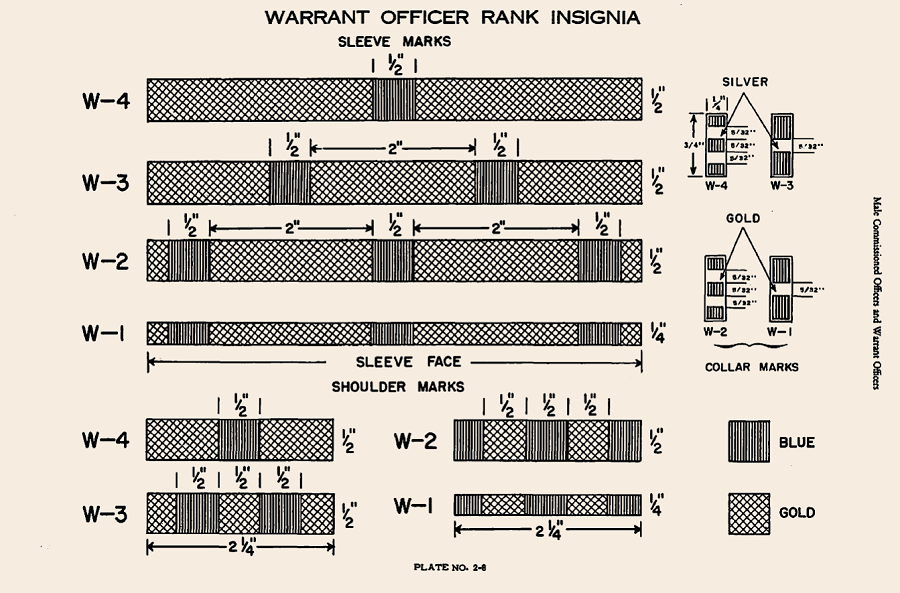 |
| The new warrant officer insignia as illustrated in Change Number 1 to the 1951 Uniform Regulations. Author's collection. |
| cap badge |  |  | ||
| collar devices |   |   |   |   |
| shoulder marks |  |  |  |  |
Legislation and naval administration had begun to consider all warrant officers of the same grade as the same rank, rather than the different designations – boatswain, carpenter and so on – being considered as separate but equivalent ranks. With legislation no longer being required to create individual warrant ranks, the number of warrant specialties began to multiply in the late 1950s, and many traditional titles were changed (gunner became surface ordnance technician, carpenter became ship repair technician and so on). The author does not have adequate references for the dates of authorization for all the subsequent insignia, and so they are not included in this study.
Change Number 1 to the 1959 uniform regulations authorized the standard gold stripes for women's service dress white, in place of the previous white braid stripes. 11
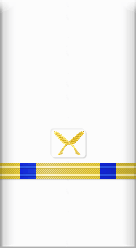 |
| Chief Warrant Officer W-3 (Ship's Clerk), Women's Service Dress White |
Effective in 1992, Congress authorized the armed forces an additional warrant grade: Chief Warrant Officer W-5. 8 The Navy had no plans to utilize the grade until 2002, at which time new insignia were also authorized. Instead of following the former pattern of senior ranks decreasing the differences from the basic gold stripe, the existing CW-4 stripe was augmented with a narrow blue line along the center. 12 The metal pin rank insignia was a silver bar with a lengthwise blue center line, based on a 1970 design by the Department of the Army Institute of Heraldry. 8 On October 1, 2003 the first U.S. Navy CWO-5 was promoted aboard USS Ronald Reagan. 13
| cap badge |  |
| collar devices |   |
| shoulder marks |  |
| sleeve | 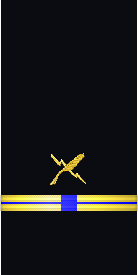 |
| Chief Warrant Officer W-5 (Cryptologic Technician) |
All text and images © Justin T. Broderick, 2014 unless otherwise indicated.